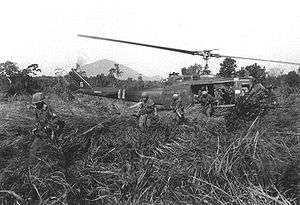Operation Attleboro
| Operation Attleboro | |||||||
|---|---|---|---|---|---|---|---|
| Part of the Vietnam War | |||||||
 Infantrymen attacking out of a UH-1D helicopter during Operation Attleboro. | |||||||
| |||||||
| Belligerents | |||||||
|
|
| ||||||
| Commanders and leaders | |||||||
|
Guy S. Meloy William E. DePuy | Unknown | ||||||
| Units involved | |||||||
|
196th Light Infantry Brigade 1st Infantry Division 4th Infantry Division 27th Infantry Regiment |
| ||||||
| Casualties and losses | |||||||
| 155 killed and 494 wounded |
US report: 2,130 killed 44 POW | ||||||
Operation Attleboro was a Vietnam War search and destroy operation by the 196th Light Infantry Brigade with the objective to discover the location(s) of the North Vietnamese or Viet Cong base areas and force them to fight. The operation was named after Attleboro, Massachusetts, where the brigade had been formed. Operation Attleboro turned out to be the largest series of air mobile operations to that time, involving all or elements of the 196th Light Infantry Brigade, 25th Division, 1st Infantry Division, and a brigade of the 4th Division, as well as numerous Army of the Republic of Vietnam and Regional Forces/Popular Forces and Nungs. In the end, the operation became a corps operation commanded by II Field Forces.
Operation
The 196th Light Infantry Brigade initiated Operation Attleboro on September 14, 1966 in the Tay Ninh Province, however no significant contact was made with North Vietnamese Army (NVA) or Viet Cong (VC) forces until October 19, 1966 when a sizable NVA base area was discovered.[1] By early November, U.S. forces had expanded to include the 1st and 2nd battalions of the 27th Infantry Regiment (25th Infantry Division), the 3rd Brigade of the 4th Infantry Division, the 173rd Airborne Brigade, and two brigades of the 1st Infantry Division.[2]
The most significant fighting occurred when Viet Cong forces assaulted the US perimeter at Suoi Da on November 8. The assault was defeated by artillery and air strikes. Afterwards, a large Viet Cong base camp was detected. It was one of the largest hauls to date in the war, with the American forces seizing two million pounds of rice; 116 transportation bicycles; approximately 25,000 Chinese-made hand grenades (many containing tear gas); 481 M18 Claymore anti-personnel mines; 80 rocket launchers; 25 machine guns; myriad number of pistols; rifles like AKMs and AK-47s; clothing; tobacco; miscellaneous foods like cooking oil, salt and fish; and bountiful gallons of petroleum.
Operation Attleboro was the first field test of the U.S. Army's new search and destroy doctrine and set a pattern that would be later exhibited other large operations including Cedar Falls and Junction City. These operations began with massive B-52 Arc Light bombing strikes followed by helicopter and ground sweeps that usually made sporadic contact with VC and NVA forces. Americans often uncovered evidence of hasty departure (i.e. abandoned camps, vacated tunnels, caches of food and supplies) indicating that the communist forces had been alerted by the preparations for upcoming search-and-destroy missions.[3]
Aftermath
US intelligence later estimated VC/PAVN losses during Operation Attleboro as 2,130 killed, 900 wounded, and over 200 missing or captured. Allied losses totaled 155 killed and 494 wounded.[4]
U.S. military spokesmen claimed that the most significant result of Operation Attleboro was the severe blow struck against the communists' supply system. In fact, however, the operation failed to eradicate the Viet Cong's political domination in Tay Ninh Province, as they quietly returned to the area from their sanctuaries in Cambodia just after the American withdrawal.[5]
Notes
- ↑ Summers, The Vietnam War Almanac, p. 39-40.
- ↑ Olson, In Country: The Illustrated Encyclopedia of the Vietnam War, p. 415.
- ↑ Kutler, Encyclopedia of the Vietnam War, p. 516.
- ↑ Tucker 2011, p. 81.
- ↑ Daddis 2011, p. 7.
References
- Summers Jr., Harry G. (1985). The Vietnam War Almanac. New York: Random House. ISBN 0-7394-4290-2. OCLC 9730994.
- Kutler, Stanley I. (1996). Encyclopedia of the Vietnam War. New York: Charles Scribner’s Sons. ISBN 0-13-276932-8. OCLC 32970270.
- Olson, James S. (2008). In Country: The Illustrated Encyclopedia of the Vietnam War. New York: Metro Books. ISBN 978-1-4351-1184-4. OCLC 317495523.
- Summers, Harry G. Historical Atlas of the Vietnam War. New York: Houghton Mifflin Company.
- "Attleboro battered Reds' supply system". Stars and Stripes. 1966-11-28. Retrieved 2007-07-11.
- "The Giant Spoiler". TIME Magazine. 1966-11-18. Retrieved 2007-07-11.
- Tucker, Spencer C. (2011). The Encyclopedia of the Vietnam War: A Political, Social, and Military History (2nd ed.). Santa Barbara, California: ABC-CLIO. ISBN 9781851099603.
- Daddis, Gregory A. (2011). No Sure Victory: Measuring U.S. Army Effectiveness and Progress in the Vietnam War. New York: Oxford University Press. ISBN 9780199746873.
- "Disappearing Act". TIME Magazine. 1966-11-25. Retrieved 2007-07-11.
- "Encouraging Returns". TIME Magazine. 1966-12-09. Retrieved 2007-07-11.